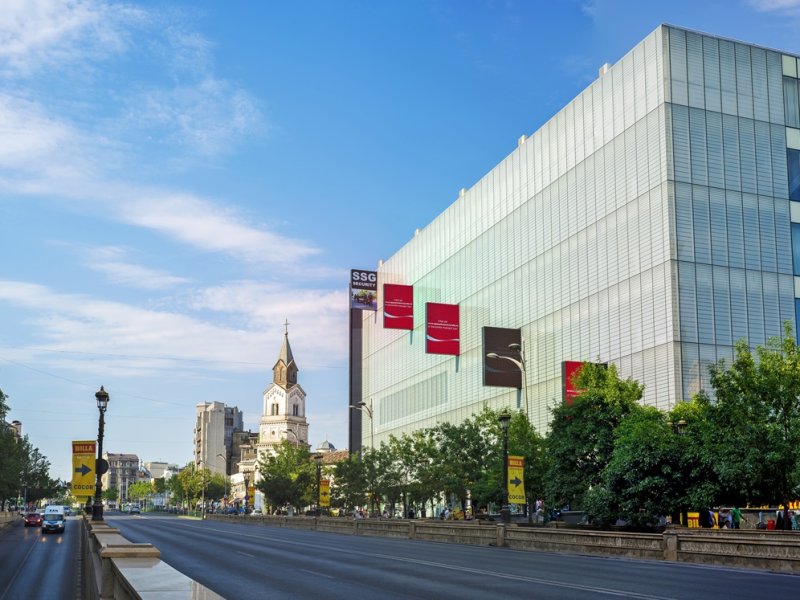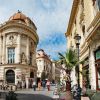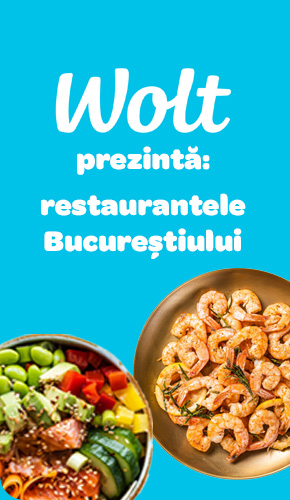What once was, what remains – iconic communist-era department stores and what they’ve become

By Bucharest Team
- Articles
Before the rise of shopping malls, Bucharest had its own monumental stores – vast façades with displays that promised more than they could deliver. For generations raised under communism, they were symbols of the city and of a promised modernity. Today, those buildings still stand – some nearly abandoned, others undergoing reinvention. The question is no longer “what were they?” but “what can they become?”
Unirea Shopping Center – between decay and reinvention
Unquestionably the most iconic store of postwar Bucharest, Unirea was a colossus of its time – a brutalist behemoth that drew crowds with its modern escalators, glassy window displays, and even an early version of a food court. It was the city’s first glimpse of Western-style consumerism.
Time, however, has not been kind. In recent years, the building visibly deteriorated, tenants left, and shoppers drifted toward newer centers. Now, a full repositioning is in motion. The new plan aims to reimagine the space as a multifunctional hub: a mix of retail, restaurants, rooftop bars, cultural zones, co-working areas, and entertainment. A radical departure from the fashion-focused model it once embodied.
The transformation will happen in phases, in parallel with the major infrastructure overhaul of Piața Unirii, one of the city's most trafficked zones. If it works, Unirea could become once again a key destination – not just for shopping, but as a multifunctional urban node.
Magazinul București – between memory and reinvention
Before World War II, it was one of the most modern department stores in Eastern Europe. After nationalization, it became a central, state-run commercial hub – functional, standardized, and crowded. Its closure in the 2000s left a visible gap in the urban fabric near University Square.
Today, the building is undergoing full reconstruction, with the original façade preserved. The new concept combines retail, office spaces, and a panoramic rooftop restaurant. It’s a rare case of the past being restored with the explicit intent to function in the city’s contemporary rhythm.
Cocor – modernized, but directionless
Cocor was intended as a smaller-scale counterpart to Unirea: equally central, equally ambitious. Though renovated over a decade ago, it remains caught in commercial limbo – partially occupied, partially ignored. It houses fashion boutiques, beauty services, and a handful of shops, but lacks a clear identity or draw.
Still, its strategic location between Unirii and Universitate leaves room for reinvention. In a city learning how to merge memory with function, Cocor may yet get a second chance.
Other forgotten or transformed landmarks
- Romarta Copiilor, once a paradise for children, is now a sterile retail space with no connection to its past.
- Magazinul Eva, once iconic for women’s fashion in the 1980s, is now just a shadow of its former self.
- Victoria, once a luxury department store buzzing with shoppers on every floor, still operates quietly – almost anonymously.
- Magazinul Junior (now part of Cocor), formerly a go-to for toys and children’s wear, has been entirely remodelled.
- Comturist, once the semi-exclusive store for Western imports – where the lucky few could find Toblerone or Levi’s – now only retains its name on the façade. The interior is fragmented and stripped of its former identity.
Rebranding, not just renovation
The point isn’t just to renovate old buildings, but to reinvent them without erasing memory. These projects will succeed only if the city can integrate them meaningfully into daily life – not just through architecture or leasing, but through relevance.
In a city where malls have long defined urbanism, returning to the center can be more than an economic strategy – it can be a cultural statement. Because these stores weren’t just selling products. They were selling a vision of what the future could look like.






























